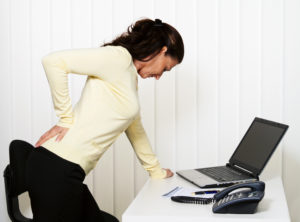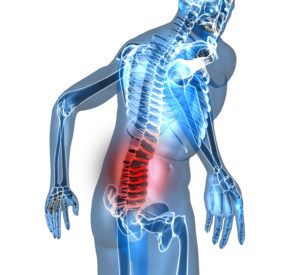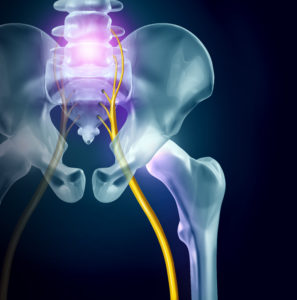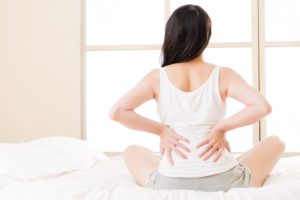September 7th, 2018 by
It’s estimated that around 80% of adults will experience lower back pain at some point in their lives. As backaches like this are so common, it’s impossible to pinpoint one single cause and treatment for all types of back pain; they can be caused by countless different issues with your nerves, spine, or muscles. Below, we’ll outline some of the most common causes of lower back pain and let you know how you can treat your back pain.
Non-Specific Back Pain
 Non-specific back pain is the most common kind of lower back pain. It’s a term that describes times when your back pain isn’t coming from an obvious source, and it usually clears up quickly on its own. Non-specific back pain can come from a sprain, a strain, or just general wear and tear on your back. It’s commonly brought on by bad posture, especially in people who sit in office chairs all day at work.
Non-specific back pain is the most common kind of lower back pain. It’s a term that describes times when your back pain isn’t coming from an obvious source, and it usually clears up quickly on its own. Non-specific back pain can come from a sprain, a strain, or just general wear and tear on your back. It’s commonly brought on by bad posture, especially in people who sit in office chairs all day at work.
How to Treat Non-Specific Back Pain
You can usually treat back pain with a soothing heat treatment. An electric heat pad applied to your lower back will increase blood flow to the area, improving flexibility and relieving your pain. You can prevent back pain from coming back by regularly exercising your core muscles – stronger muscles are less prone to strains and they’ll also help protect your spine much better. If you sit in an office chair all day, make sure you stand up regularly to avoiding weakening your core too much.
Lower Back Pain from Arthritis
Arthritis is a condition caused by the wearing away of protective cartilage in between your joints, leading to stiffness and pain when you try to move. There are actually many different kinds of arthritis, including some that specifically affect your spine. Usually, symptoms of arthritis in the back include stiffness in your lower back or tenderness and swelling. Often, this pain will feel better when lying down.
How to Treat Arthritis Pain
 Arthritis pain can usually be treated with exercise and weight management. Losing weight reduce the amount of pressure on your spine while also helping you remain more flexible and generally helping you reduce the overall pain in your back. You can also use heat and ice to treat the different types of pain that commonly come with arthritis. If your back feels swollen, warm, and tender, you should use an ice pack to help reduce the swelling and numb some of the pain. If your back feels stiff and achy, you should use a heat pad to improve flexibility and increase circulation. You can get specialist lower back heat pads that fit around your waist with a supportive strap to apply heat directly to the source of your back pain. Combine these heat and ice treatments with over-the-counter painkillers and regular light exercise and you should be able to manage your pain very effectively.
Arthritis pain can usually be treated with exercise and weight management. Losing weight reduce the amount of pressure on your spine while also helping you remain more flexible and generally helping you reduce the overall pain in your back. You can also use heat and ice to treat the different types of pain that commonly come with arthritis. If your back feels swollen, warm, and tender, you should use an ice pack to help reduce the swelling and numb some of the pain. If your back feels stiff and achy, you should use a heat pad to improve flexibility and increase circulation. You can get specialist lower back heat pads that fit around your waist with a supportive strap to apply heat directly to the source of your back pain. Combine these heat and ice treatments with over-the-counter painkillers and regular light exercise and you should be able to manage your pain very effectively.
Lower Back Pain from Sciatica
 Sciatica isn’t actually a condition in and of itself; it’s a symptom of an underlying issue. Sciatica occurs when something puts pressure on or otherwise irritates your sciatic nerve, which runs down from your hips, through your legs, and into your feet. Sciatica pains can affect your lower back, your leg, or your feet, but the root cause is usually an issue in your back disturbing the sciatic nerve. This can be scar tissue, muscle strains and inflammation putting pressure on the nerve, or a slipped disc in your spine. Sciatica pain can be a tingling pins and needles-type feeling, a dull ache, or a stabbing pain that can occur anywhere from your hips down through either one of your legs.
Sciatica isn’t actually a condition in and of itself; it’s a symptom of an underlying issue. Sciatica occurs when something puts pressure on or otherwise irritates your sciatic nerve, which runs down from your hips, through your legs, and into your feet. Sciatica pains can affect your lower back, your leg, or your feet, but the root cause is usually an issue in your back disturbing the sciatic nerve. This can be scar tissue, muscle strains and inflammation putting pressure on the nerve, or a slipped disc in your spine. Sciatica pain can be a tingling pins and needles-type feeling, a dull ache, or a stabbing pain that can occur anywhere from your hips down through either one of your legs.
How to Treat Sciatica Pain
How you should treat sciatica depends on the severity of the pain and what the cause of it actually is. If it’s a muscle problem, you can use a heat pad on your back (or your legs if that’s where the pain is) to soothe the pain. You can also take anti-inflammatory painkillers like ibuprofen to help reduce pressure on the sciatic nerve. Try complementing these treatments with back stretches and regular exercises to help keep your back flexible, which should help to relieve some of your pain. If the pain is very severe, or if it doesn’t stop after a few weeks of home treatment, you should see your doctor.
Lower Back Pain as a Result of Pinched Nerves
 Sciatica is a specific type of nerve compression, but other nerves in your back can also become compressed, which can cause varying degrees of back pain. While pinched nerves can occur anywhere in the body, most nerves in the body ultimately lead back to the spinal cord, so they’re most common in the back. As the name suggests, nerve compression happens when another tissue in your body – like an inflamed muscle, tendon, or displaced bone - puts pressure on your nerve, sending pain signals shooting to your brain. Pinched nerve pain can range from dull, uncomfortable aches to sharp stabbing pains depending on how irritated the nerve is.
Sciatica is a specific type of nerve compression, but other nerves in your back can also become compressed, which can cause varying degrees of back pain. While pinched nerves can occur anywhere in the body, most nerves in the body ultimately lead back to the spinal cord, so they’re most common in the back. As the name suggests, nerve compression happens when another tissue in your body – like an inflamed muscle, tendon, or displaced bone - puts pressure on your nerve, sending pain signals shooting to your brain. Pinched nerve pain can range from dull, uncomfortable aches to sharp stabbing pains depending on how irritated the nerve is.
Treatment for Pinched Nerves in the Back
Treatment for pinched nerves depends greatly on what the cause of the pain is. Usually, the best treatment for a pinched nerve is simply to rest. It’s not advised to use heat or ice on a suspected pinched nerve until you know what the cause is, so make sure you see your doctor if the pain is severe or if it suddenly gets worse. If your nerve pain doesn’t disappear after a couple of weeks rest, you should also consider seeing your GP.
Lower Back Pain During Your Period
 Back Pain is extremely common during your period, and it’s nothing to worry about. During this time of the month, your stomach will start contracting slightly, which can disturb the nerves throughout your pelvis and lower back resulting in a dull, throbbing pain. It’s a normal side-effect of a natural process that can normally be managed quite easily.
Back Pain is extremely common during your period, and it’s nothing to worry about. During this time of the month, your stomach will start contracting slightly, which can disturb the nerves throughout your pelvis and lower back resulting in a dull, throbbing pain. It’s a normal side-effect of a natural process that can normally be managed quite easily.
Treatment for Lower Back Pain During Your Period
Often, pain in your back during your period can be managed with painkillers and a heated cushion, which will provide both the heat your body needs to improve circulation and a comforting, soft pillow to hold. You can also help relax your muscles by eating foods high in magnesium, such as avocados, almonds, and oatmeal, which should help reduce some of the tension in your back.
When to See a Doctor About Your Lower Back Pain
While back pain is uncomfortable and can often disrupt your life, it’s usually nothing to worry about and can be managed with painkillers, rest, and heat pad treatments. Even if your pain feels quite bad, it doesn’t necessarily mean there’s anything major to worry about. However, in very rare cases, back pain can be a sign of something more serious. You should see your doctor if your back pain fits any of these descriptions, especially if you’re over 50:
- Your back pain appeared suddenly and doesn’t go away for at least 2 weeks
- Your back pain gets noticeably worse over time, rather than better
- You start to get a weakness or a numbness in both legs
- Your back pain coincided with feverish symptoms
- You have a numbness around your pelvic region
- Your back pain makes it hard to go to the toilet, or if it makes you go to the toilet much more than usual
Comments
Leave a reply
Your e-mail address will not be published. All fields are required


